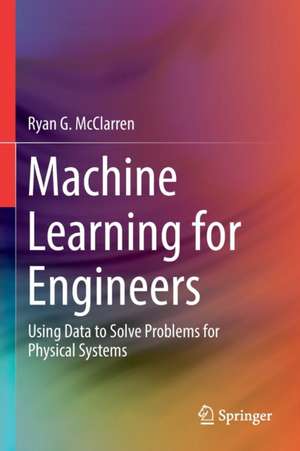Machine Learning for Engineers: Using data to solve problems for physical systems
Autor Ryan G. McClarrenen Limba Engleză Paperback – 23 sep 2022
| Toate formatele și edițiile | Preț | Express |
|---|---|---|
| Paperback (1) | 337.41 lei 3-5 săpt. | +18.09 lei 5-11 zile |
| Springer International Publishing – 23 sep 2022 | 337.41 lei 3-5 săpt. | +18.09 lei 5-11 zile |
| Hardback (1) | 471.17 lei 3-5 săpt. | +25.29 lei 5-11 zile |
| Springer International Publishing – 22 sep 2021 | 471.17 lei 3-5 săpt. | +25.29 lei 5-11 zile |
Preț: 337.41 lei
Preț vechi: 421.75 lei
-20% Nou
Puncte Express: 506
Preț estimativ în valută:
64.57€ • 67.16$ • 53.31£
64.57€ • 67.16$ • 53.31£
Carte disponibilă
Livrare economică 24 martie-07 aprilie
Livrare express 08-14 martie pentru 28.08 lei
Preluare comenzi: 021 569.72.76
Specificații
ISBN-13: 9783030703905
ISBN-10: 3030703908
Pagini: 247
Ilustrații: XIII, 247 p. 106 illus., 90 illus. in color.
Dimensiuni: 155 x 235 x 25 mm
Greutate: 0.37 kg
Ediția:1st ed. 2021
Editura: Springer International Publishing
Colecția Springer
Locul publicării:Cham, Switzerland
ISBN-10: 3030703908
Pagini: 247
Ilustrații: XIII, 247 p. 106 illus., 90 illus. in color.
Dimensiuni: 155 x 235 x 25 mm
Greutate: 0.37 kg
Ediția:1st ed. 2021
Editura: Springer International Publishing
Colecția Springer
Locul publicării:Cham, Switzerland
Cuprins
Part I Fundamentals.- 1. Introduction.- 2. The landscape of machine learning.- 3. Linear models.- 4. Tree-based models.- 5. Clustering data.- Part II Deep Neural Networks.- 6. Feed-forward Neural networks.- 7.convolutional neural networks.- 8. Recurrent neural networks for time series data.- Part III Advanced topics in machine learning.- 9. Unsupervised learning with neural networks.- 10. Reinforcement learning.- 11. Transfer learning.- Part IV Appendixes.- Appendix A. Sci-Kit learn.- Appendix B. Tensorflow.
Notă biografică
Ryan McClarren, Associate Professor of Aerospace and Mechanical Engineering at the University of Notre Dame, has applied machine learning to understand, analyze, and optimize engineering systems throughout his academic career. He has authored numerous publications in refereed journals on machine learning, uncertainty quantification, and numerical methods, as well as two scientific texts: Uncertainty Quantification and Predictive Computational Science: A Foundation for Physical Scientists and Engineers and Computational Nuclear Engineering and Radiological Science Using Python. A well-known member of the computational engineering community, Dr. McClarren has won research awards from NSF, DOE, and three national labs. Prior to joining Notre Dame in 2017, he was Assistant Professor of Nuclear Engineering at Texas A&M University, and previously a research scientist at Los Alamos National Laboratory in the Computational Physics and Methods group. While an undergraduate at the University of Michigan he won three awards for creative writing.
Textul de pe ultima copertă
All engineers and applied scientists will need to harness the power of machine learning to solve the highly complex and data intensive problems now emerging. This text teaches state-of-the-art machine learning technologies to students and practicing engineers from the traditionally “analog” disciplines—mechanical, aerospace, chemical, nuclear, and civil. Dr. McClarren examines these technologies from an engineering perspective and illustrates their specific value to engineers by presenting concrete examples based on physical systems. The book proceeds from basic learning models to deep neural networks, gradually increasing readers’ ability to apply modern machine learning techniques to their current work and to prepare them for future, as yet unknown, problems. Rather than taking a black box approach, the author teaches a broad range of techniques while conveying the kinds of problems best addressed by each. Examples and case studies in controls, dynamics, heat transfer, and other engineering applications are implemented in Python and the libraries scikit-learn and tensorflow, demonstrating how readers can apply the most up-to-date methods to their own problems. The book equally benefits undergraduate engineering students who wish to acquire the skills required by future employers, and practicing engineers who wish to expand and update their problem-solving toolkit.
Caracteristici
Illustrates concepts with examples and case studies drawn from engineering science Presents detailed coverage of deep neural networks for practical applications in engineering science Provides source code in Python for rapid application to a variety of physical systems' problems
